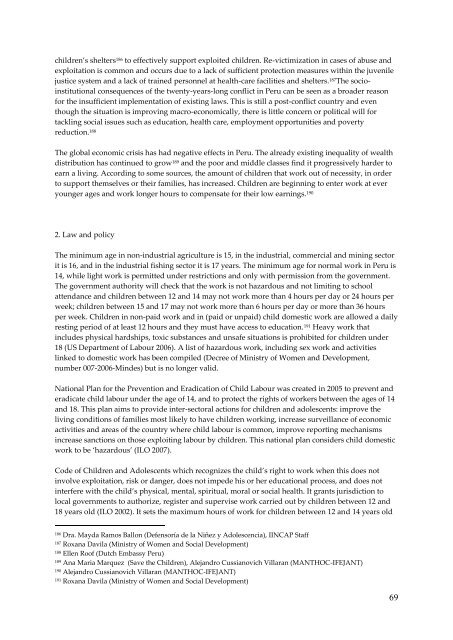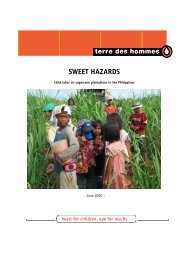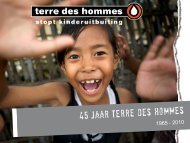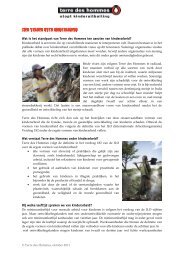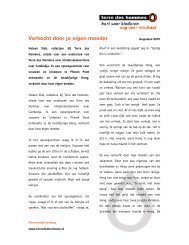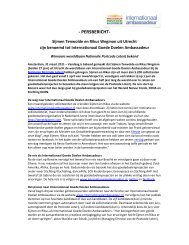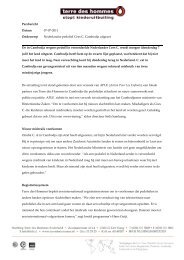Untitled - Terre des Hommes
Untitled - Terre des Hommes
Untitled - Terre des Hommes
- No tags were found...
You also want an ePaper? Increase the reach of your titles
YUMPU automatically turns print PDFs into web optimized ePapers that Google loves.
children’s shelters 186 to effectively support exploited children. Re-victimization in cases of abuse and<br />
exploitation is common and occurs due to a lack of sufficient protection measures within the juvenile<br />
justice system and a lack of trained personnel at health-care facilities and shelters. 187 The socioinstitutional<br />
consequences of the twenty-years-long conflict in Peru can be seen as a broader reason<br />
for the insufficient implementation of existing laws. This is still a post-conflict country and even<br />
though the situation is improving macro-economically, there is little concern or political will for<br />
tackling social issues such as education, health care, employment opportunities and poverty<br />
reduction. 188<br />
The global economic crisis has had negative effects in Peru. The already existing inequality of wealth<br />
distribution has continued to grow 189 and the poor and middle classes find it progressively harder to<br />
earn a living. According to some sources, the amount of children that work out of necessity, in order<br />
to support themselves or their families, has increased. Children are beginning to enter work at ever<br />
younger ages and work longer hours to compensate for their low earnings. 190<br />
2. Law and policy<br />
The minimum age in non-industrial agriculture is 15, in the industrial, commercial and mining sector<br />
it is 16, and in the industrial fishing sector it is 17 years. The minimum age for normal work in Peru is<br />
14, while light work is permitted under restrictions and only with permission from the government.<br />
The government authority will check that the work is not hazardous and not limiting to school<br />
attendance and children between 12 and 14 may not work more than 4 hours per day or 24 hours per<br />
week; children between 15 and 17 may not work more than 6 hours per day or more than 36 hours<br />
per week. Children in non-paid work and in (paid or unpaid) child domestic work are allowed a daily<br />
resting period of at least 12 hours and they must have access to education. 191 Heavy work that<br />
inclu<strong>des</strong> physical hardships, toxic substances and unsafe situations is prohibited for children under<br />
18 (US Department of Labour 2006). A list of hazardous work, including sex work and activities<br />
linked to domestic work has been compiled (Decree of Ministry of Women and Development,<br />
number 007-2006-Min<strong>des</strong>) but is no longer valid.<br />
National Plan for the Prevention and Eradication of Child Labour was created in 2005 to prevent and<br />
eradicate child labour under the age of 14, and to protect the rights of workers between the ages of 14<br />
and 18. This plan aims to provide inter-sectoral actions for children and adolescents: improve the<br />
living conditions of families most likely to have children working, increase surveillance of economic<br />
activities and areas of the country where child labour is common, improve reporting mechanisms<br />
increase sanctions on those exploiting labour by children. This national plan considers child domestic<br />
work to be ‘hazardous’ (ILO 2007).<br />
Code of Children and Adolescents which recognizes the child’s right to work when this does not<br />
involve exploitation, risk or danger, does not impede his or her educational process, and does not<br />
interfere with the child’s physical, mental, spiritual, moral or social health. It grants jurisdiction to<br />
local governments to authorize, register and supervise work carried out by children between 12 and<br />
18 years old (ILO 2002). It sets the maximum hours of work for children between 12 and 14 years old<br />
186<br />
Dra. Mayda Ramos Ballon (Defensoría de la Niñez y Adolescencia), IINCAP Staff<br />
187<br />
Roxana Davila (Ministry of Women and Social Development)<br />
188<br />
Ellen Roof (Dutch Embassy Peru)<br />
189<br />
Ana Maria Marquez (Save the Children), Alejandro Cussianovich Villaran (MANTHOC-IFEJANT)<br />
190<br />
Alejandro Cussianovich Villaran (MANTHOC-IFEJANT)<br />
191<br />
Roxana Davila (Ministry of Women and Social Development)<br />
69


